What do you get when you cross kids with paintbrushes and a passion for environmental change? You get ‘artivism’ – a powerful blend of art and activism that can transform hearts and minds.
At Greenpeace, we are always inspired by the power of art to drive change and make a difference. We are thrilled to showcase the incredible ‘artivism’ from the students of Living School Lismore. These young artists have not only embraced the challenge of advocating for nature but have done so with creativity and passion that truly embodies the spirit of environmental stewardship.
Living School strives to offer educational opportunities that fosters and nourishes responsible citizens who make positive contributions to our world. The Middle School students engaged in Project Based Learning Units, exploring Sustainable Development Goals, real world application and a focus on halving our impact across six terms. After the second term, where all students in the school have an in-depth focus on ‘Nature’, they hosed a Nature Symposium – this year marks the second year of Middle School and their second symposium.
Last year, students developed innovations to halve environmental crimes occurring in schools. This year, they worked through the Catalyst Design Thinking Framework to respond to the evocation, ‘How can we advocate for nature through art-ivism?’. These artworks and artist statements were created over just two days, in a hack-a-thon style event, supported by a local artist, staff and cross stage groupings.
Inspiring Artworks by Students from Living School Lismore
“The students’ energy throughout the event was palpable, they are so confident in their determination to call out unsustainable practices which translated powerfully to the variety of artworks created.”
Emma Wilson – Year 8 Guardian Teacher, Living School Lismore
Evermore
Indigo and Jordy
This art piece is about SDG14: Life Below Water. It is about the environment and the future that is deserved. Not for humans, but for the nature and animals surrounding us. In this painting, you will see the animals clawing at the globe of a future that they not only want, but deserve. The globe is cracking and breaking to show that it could be close. And that the animals really need this. We are hoping this sends a message to the viewers, that society’s consumption is a big role in the prevention of the future for nature that has been tainted to something humans want.
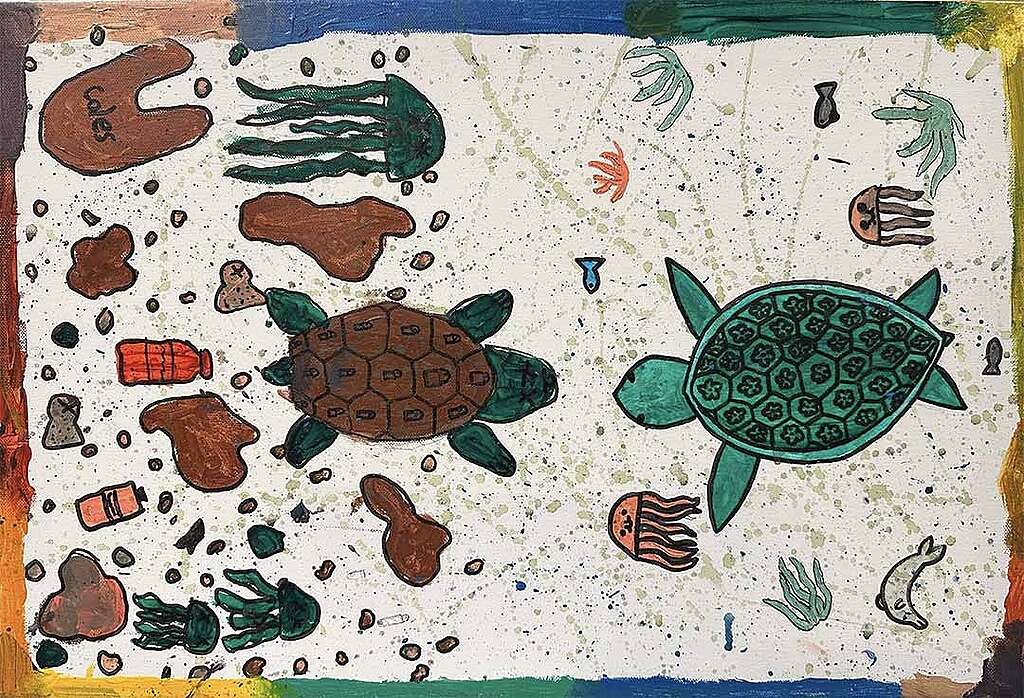
We Choose
Stella and Marli
Pollution is slowly consuming our oceans and after a while, we will have nothing left. When we disrespect, we get left with less than we had before. ‘We Choose’ is our art piece that represents pollution and beauty. We see the ocean and think of it as an amazing place. But will it be in the future? This is what is happening to our world. We used brown to represent dirty liquid in the water, we used green to represent toxic fluids and pink because it represents the blood that will be on our hands if this continues.
We also used dots to represent the lives that will be lost. If this continues, this will be the path to humanity’s extinction. But if this stops, we will see the true beauty of this world. For the beauty, we used the sea creatures to represent how much marine life will be saved. We used the seaweed to show how much the plants under water will thrive. Be caring, love the planet.
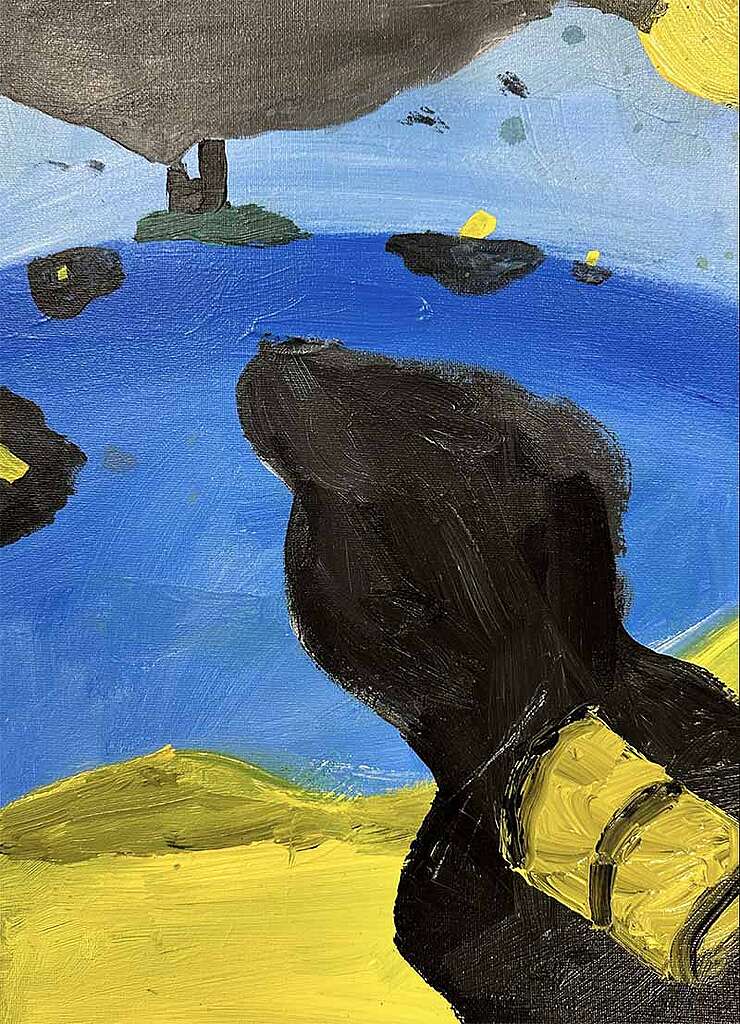
Oil Spill
Strummer
This artwork, titled ‘Oil Spill’, addresses Sustainable Development Goal 14 and 15 which focuses on land and water. The artists chose to advocate for halving our impact to stop pollution.
This artwork highlights the critical role of art in raising awareness about environmental decline, resulting in the loss of animal, earth and plant life.
Through the use of various elements of art, the artist conveys the message of environmental awareness and stewardship. Contrasting colours are used to highlight the beauty of nature and its rapid demise.
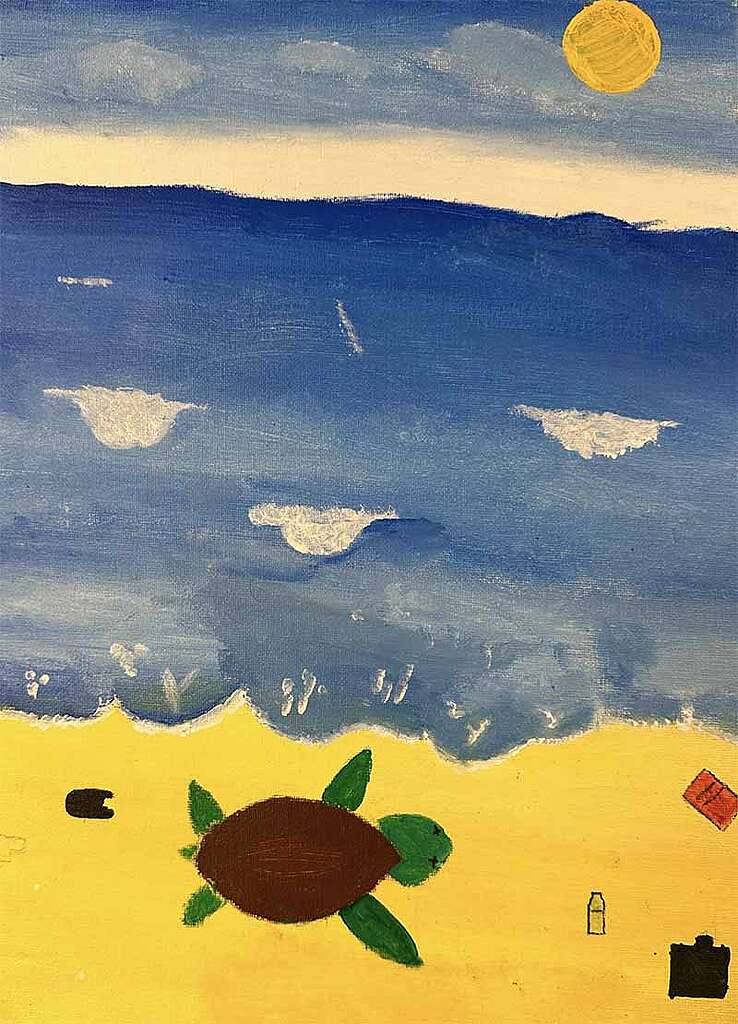
Plastic Ocean
Kai
This artwork, titled ‘Plastic Ocean’, addresses Sustainable Development Goal 15 which focuses on marine life. The artist chose to advocate for halving our impact on the pollution of the environment. This highlights the critical role of art in raising awareness about environmental decline resulting in the loss of animal homes and lives. Contrasting colours are used to highlight the beauty of nature and draw the audience’s eye.
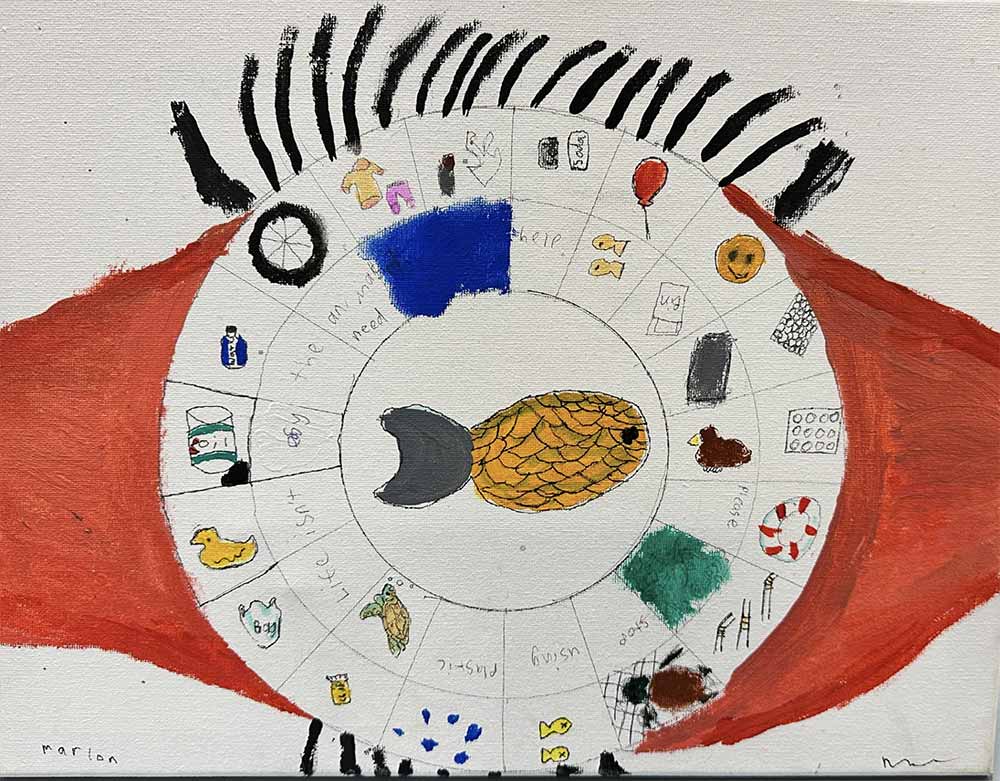
Eye to Eye
Marlon
This artwork, titled ‘Eye to Eye’, addresses Sustainable Development Goal 14 which focuses on cleaning plastics from the ocean and making the coral not bleached anymore. The artist chose to advocate for halving pollution. ‘Eye to Eye’ highlights the critical role of art in showing people the effects of pollution on our ocean and what we can do about it. By drawing the audience’s eye to the fish, the artist invites them to consider the importance of marine life. By positioning the contrasting elements of life and death around the outside of the eye, the audience is invited to consider our impact.
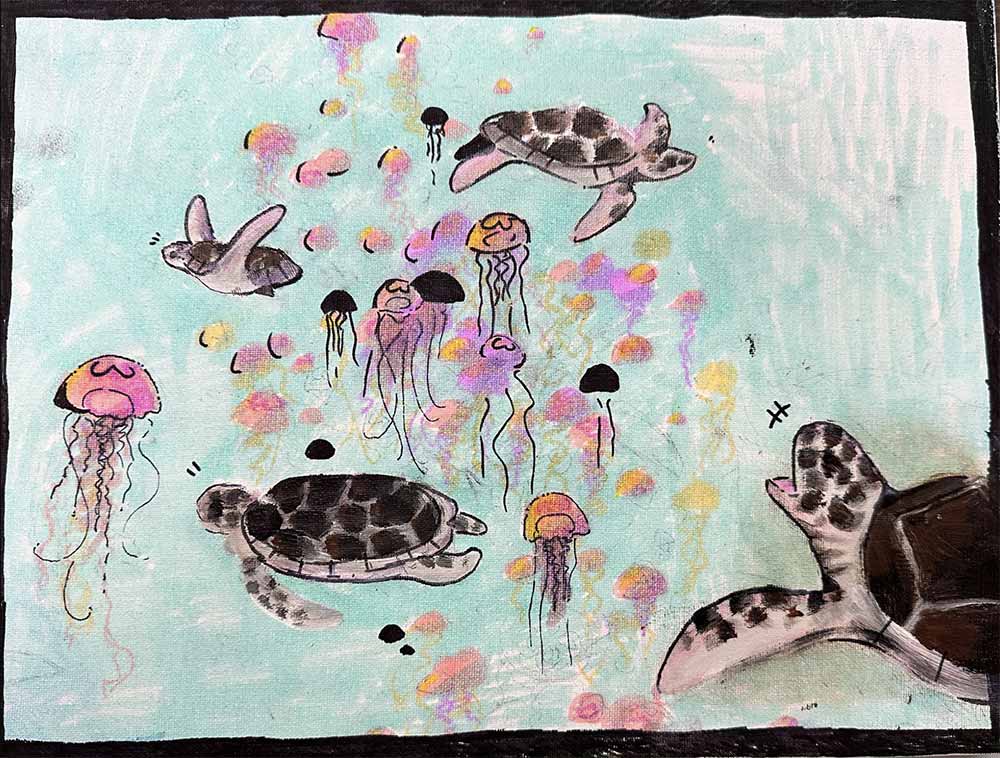
Wild Sea Turtles Consuming Jellyfish
Koco
My artwork depicts wild sea turtles consuming jellyfish but sadly, due to human impact, they end up ingesting plastic bags. The scene serves as a powerful reminder of humanity’s effects of pollution on marine life. It highlights the urgent need for sustainable practices to protect our oceans and the creators that inhabit them. By raising awareness through art, we can inspire others to take action and make a positive impact on SDG 14.
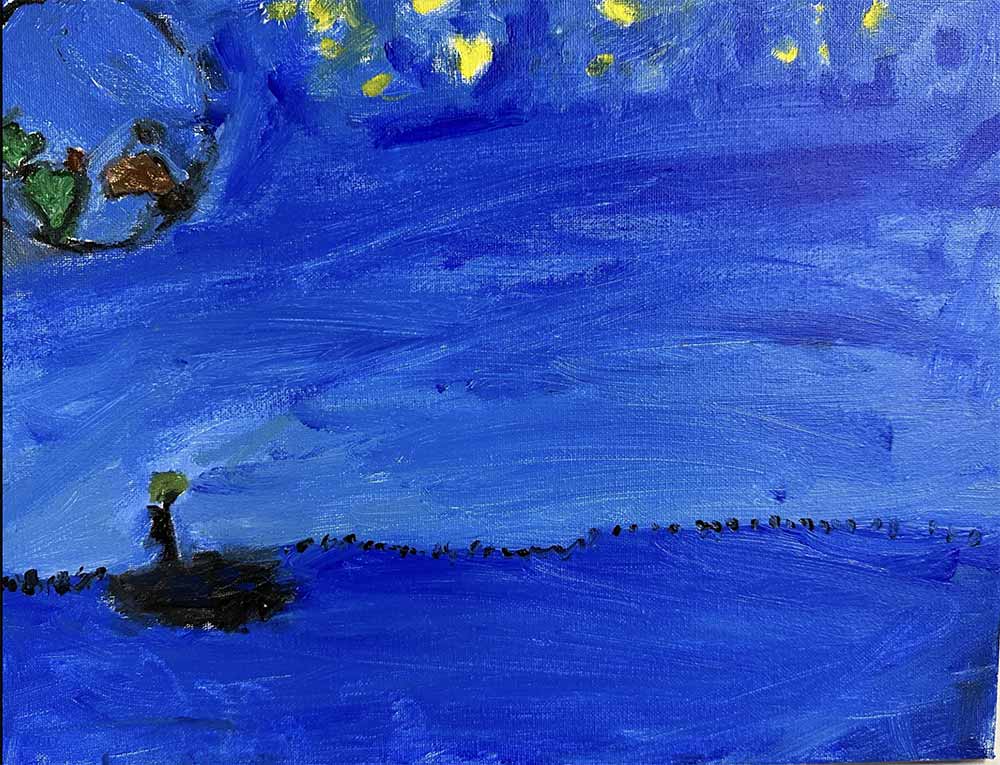
I Want In My World
Destin
The painting, ‘I Want In My World’ was created by a Living School student in Year 7 named Destin Pacanowski. The artwork addresses Sustainable Development Goal 14, which focuses on healthy creeks, lakes, oceans and rivers. Not only focusing on them being healthy but being full of life as well. The artist identifies halving pollution as a crucial step to mitigating the impact on ocean pollution.
This artwork underscores the critical role of art and raising awareness about climate change. Art-ivism has a unique ability to evoke emotions and provoke through in ways that words alone cannot. By visually depicting the effects of pollution and the major importance of sustainable practices, artists can engage viewers on a much deeper level, fostering empathy and understanding.
Through the use of various elements of arts, the artist conveys a message of environmental stewardship. Light and dark colours are embraced to show both sides of the situation in this artwork. The depth is used to show a dark night sky.
By promoting the message of reducing pollution, the artwork strives to inspire viewers to take immediate actions towards sustainability. Overall, this artwork shows a visual call to action. Embracing individuals to make continuous choices that will positively impact the environment and support those most affected by pollution all around the world.
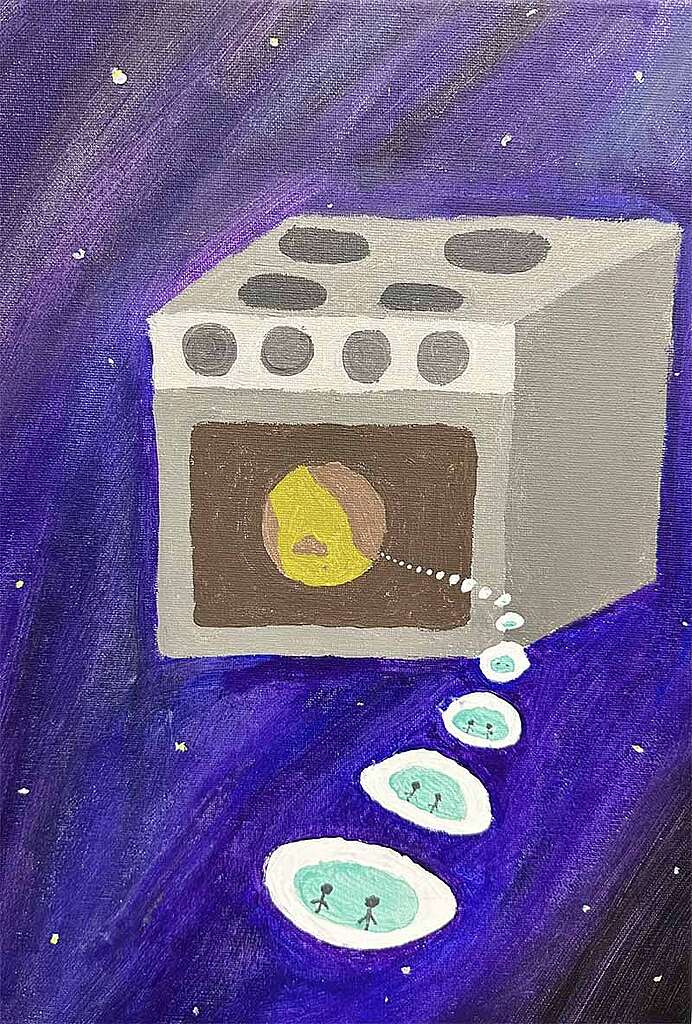
Evacuations
Annika
This piece of artwork is called, ‘Evacuation’. It is named after what is bound to happen if we don’t change our ways. ‘Evacuation’ was carefully crafted by a proud Year 8 student of Living School. It was painted to represent the pollution Halve It goal and to evoke the 13th SDG, Climate Action.
This piece shows what we will do to nature, our home planet, it we continue down this path. The earth cannot combat our advanced machinery and corrupt wats, Nature has no weapon to fight. We pillage and plunder the very thing that gives us life. This picture is showing our fate. There is NO Planet B!
Through this art, with all its many dark shades, I wish to evoke something within the viewer, whether it is anger, sadness, pain or power, something to push them. Push them to speak for the speechless, stand for the sat, empower the powerless, because now is when our earth needs us most. If we don’t answer her call, all our fates will be sealed.
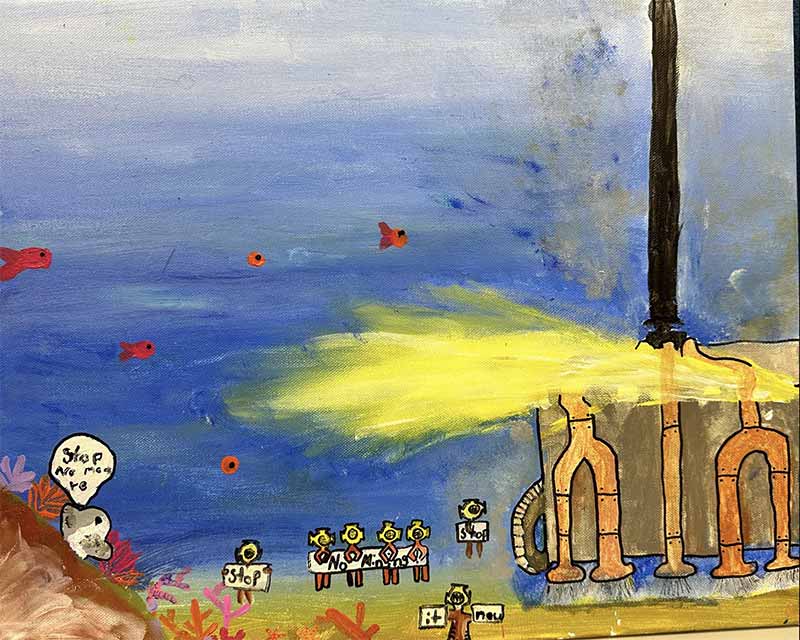
Mining Monsters
(Year 5 Student), (Year 6 Student), Lucy
This wonderful painting was created by three of the Living School’s amazing artists, (Year 5 Student), (Year 6 Student) and Lucy. Our SDG goal is number 14 – Life Below Water. Out artwork was inspired by the wonderful work that Greenpeace has done in relation to preventing deep sea mining.
The artwork explores the problem of deep sea mining where humans are wanting to extract the valuable natural resources that are found on the deep sea floor, which would destroy ecosystems that we don’t know much about yet. We are unsure of the impact this will have but prediction from the past example would suggest that this would have a negative effect.
We have used the element of shape to show that the machine is a monster to be feared of destroying sealife’s home. The element of colour has been used to show the bright life of the deep sea, even though you imagine it to be dark and frightening.
We hope our art-ivism helps the ecosystem of the deep sea to continue to thrive.
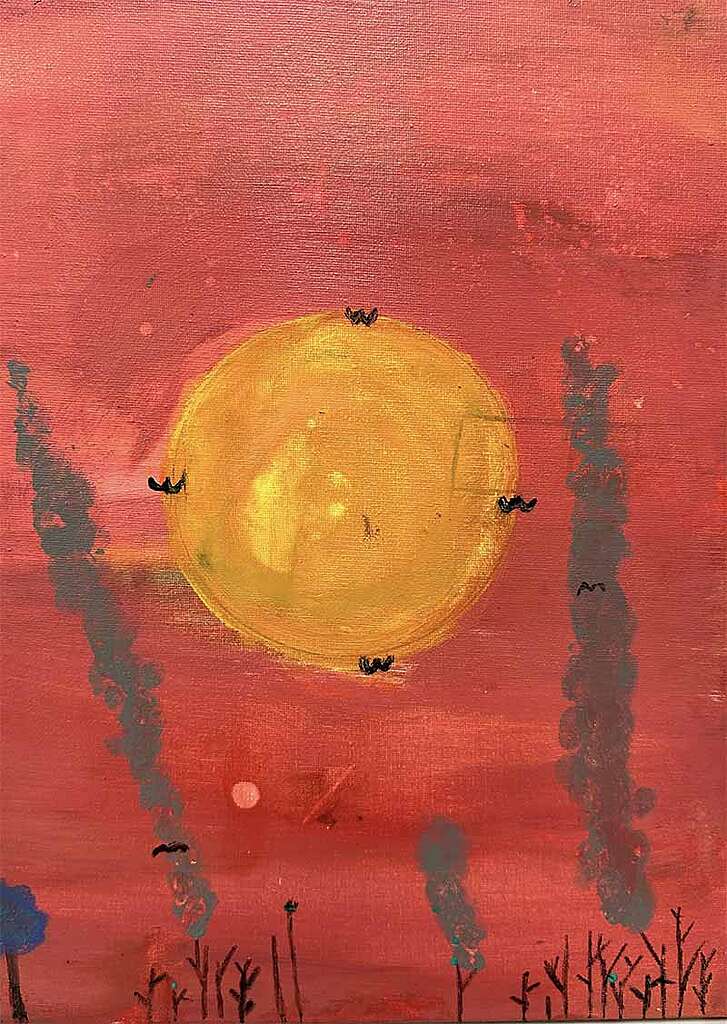
Burning Sunset
Year 5 Students
SDG 13: Climate Change/Stop burning fossil fuels
Halve It: Environment
This artwork show trees being burnt down. It shows birds dying and falling from smoke. It shows the forest turning into a desert under the setting sun.
The artist used red, orange and pink to show dryness and heat. Purple and green to show life that cannot be replaced. Black to show sadness.
The message of the artists: ‘This life can’t be replaced.’
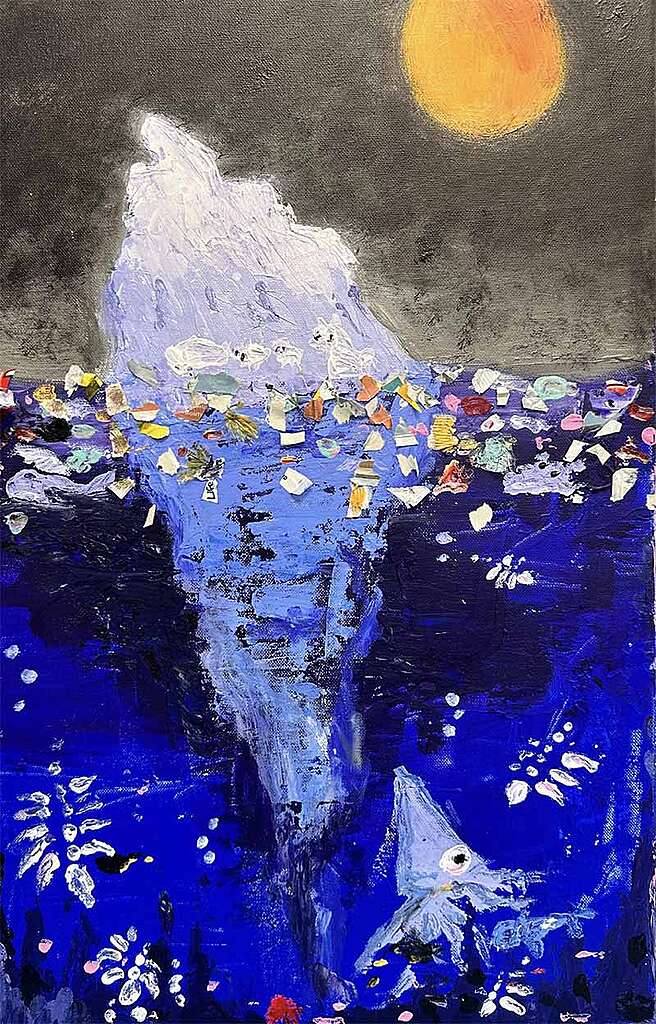
One Day
(Year 8 Student), Allie
This work of art is called, ‘One Day’. It was made by a group of talented Australian students who attend Living School in Lismore, NSW. This art is based on SDG 12, Responsible Consumption and Production.
This art piece is about the pollution that could happen in the future and global warming. The rough state of the paint encapsulates this art piece, this distinct style showing how this matter is real. Using palette knives and plastic with acrylic paint is a match that many ised ut it hard to get right.
The elements of this art is the hape language and the depth of the deep ocean and the ice using shapes and depth, this art piece truly comes to life.
This art piece was made in protest of pollution that happens in the arctic, with grand glaciers and icebergs alike starting to melt, many may write about the diverse wildlife or the arctic circles. We hope that people realise how greedy and horrible some companies are.
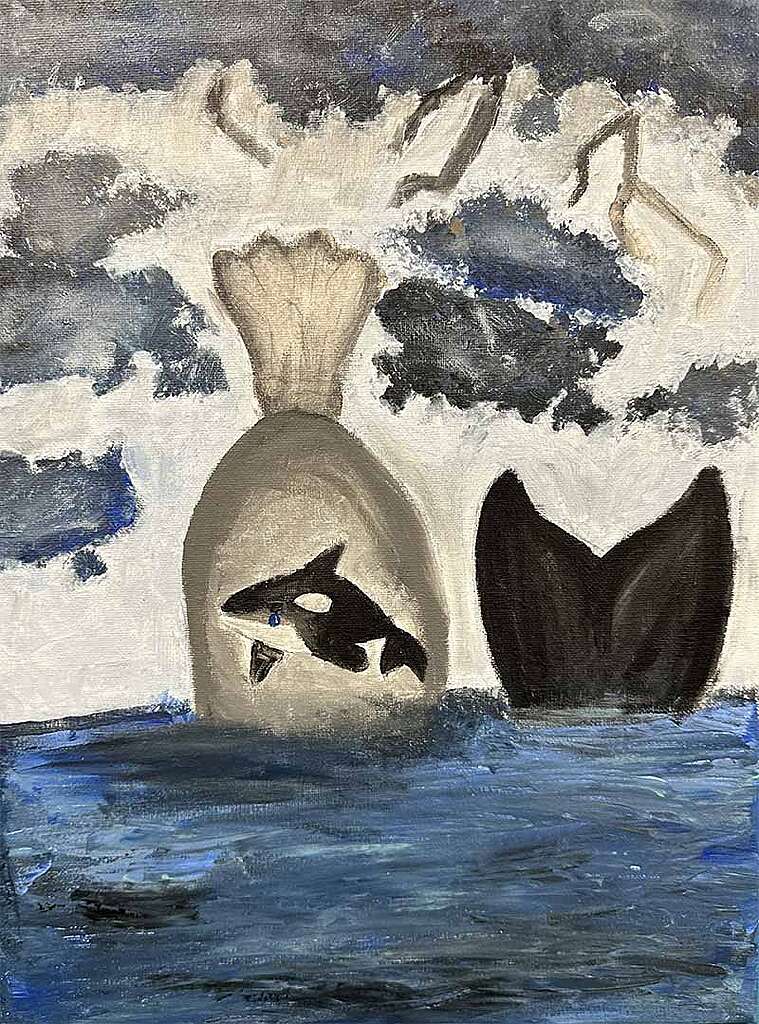
The Weeping Orca
Eve, Pearl, Ashley
Three intelligent students from Living School, Eve, Pearl and Ashley, currently in Year 5 and 6, are the creators of this awesome art work. We chose SDG 14, Life Below Water. Our artwork is inspired by the National Wildlife Federation. Our Halve It focus relates to the environment.
Our artwork is intended to help the healthy orcas in captivity. Orcas are being removed from the natural environments and placed in captivity for the purpose of human entertainment. This is extremely distressing for the animals and it also affects the vital food chain. Humans need to stop taking healthy orcas out of nature and into captive homes.
We have experienced with dark contrast colours, different strategy of shade, intense levels of depth, layering different types of textures and elements that draws in the viewer and uts the viewer in the experience of the orcas in need. This is intended to make them sad.
We hope our art-ivism will make people step into action and stop people from captivating safe and healthy orcas from their natural habitats.
If we help the orcas, we save the orcas. Start acting now.
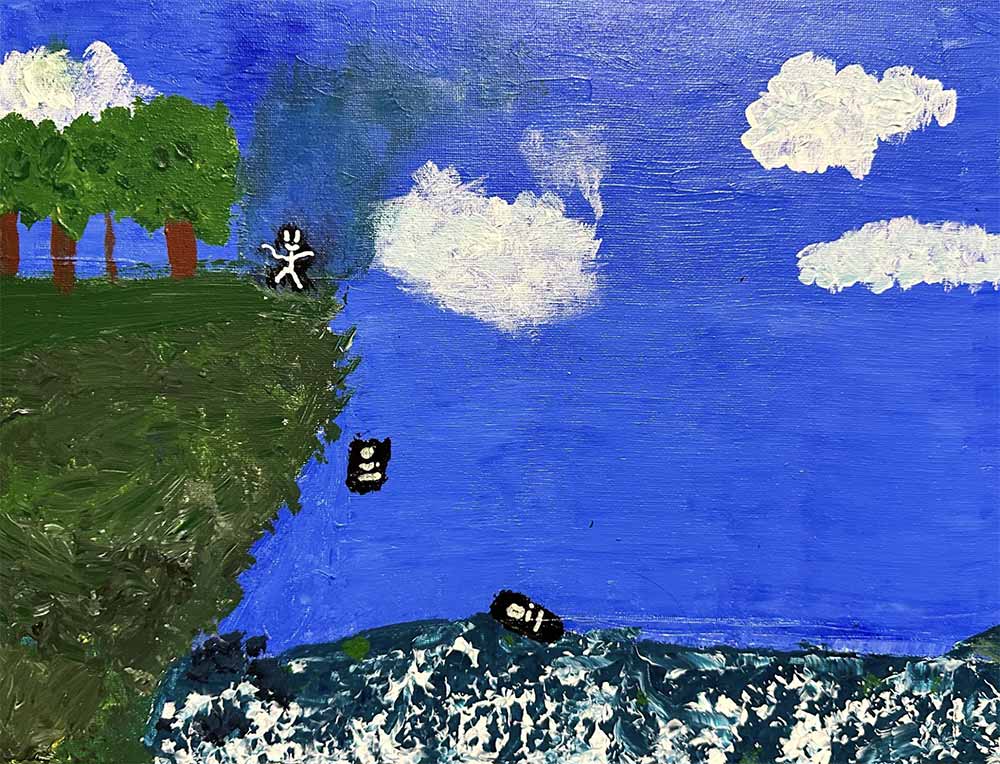
Beauty and the Barrel
Ari and Theo
This artwork, ‘Beauty and the Barrel’, was created by Ari and Theo at Living School who are in Year 5 and 8. The artwork addresses Sustainable Development Goal 14, which focuses on Life Below Water. The artist chose to advocate for halving water, which is a critical step towards minimising human impacts on water ecosystems. Oil spills and dumping oil can kill beautiful creatures in our sea, We are trying to look after our environment. We have strong feelings and are passionate for the ocean’s future.
We like fishing and snorkelling and observe amazing sea creatures. Now we see less fish, we are disappointed. Through the use of various elements of art, the artists convey a message of environmental compassion. Ocean colours make us feel calm and emphasis the beauty of the sea, the need to look after sea creatures in our hearts. Textures and a variety of colours emphasise the complexity of the ocean and its ecosystem. We have promoted awareness of keeping the ocean clean and pristine. Overall, this artwork serves as a visual recall for the urgency of rewilding and cleaning up the oceans and our planet.
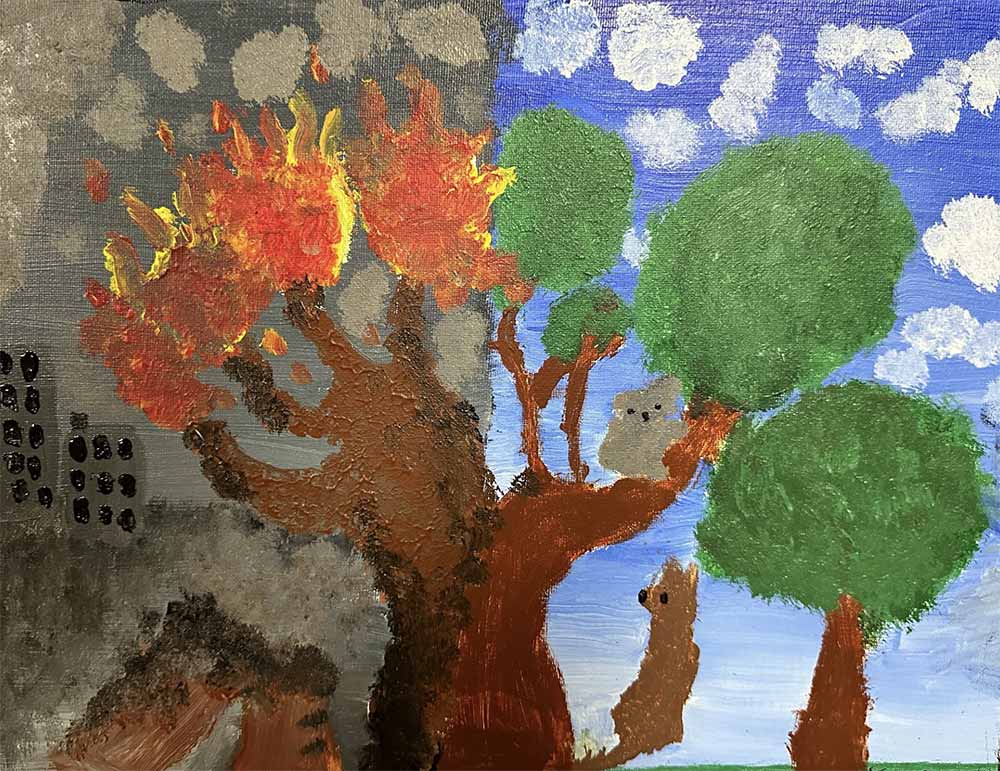
Choose Your Fate
Teo, Stella and Siân
This artwork, ‘Choose Your Fate’ is by Teo, Stella and Siân of Living School Year 8 and Year 7. The artwork addresses Sustainable Development Goal 15 which is about Life on Land and Halve It Goal of environment. The artists chose to bring attention to deforestation and protecting animals.
This artwork conveys the importance of raising awareness about climate change through art. Art has a way to provoke thoughts that words alone can not do. By depicting the effects of climate change visually, you can give viewers a deeper level of understanding and empathy.
The amazing artists used line, shape, colours, texture and space to bring their painting to life. The artists focus on animal protection is shown through two extremely contrasting perspectives of a positive and negative environment.
The artwork hopes to inspire viewers to take action and protect life on our planet and minimise climate change. Due to the extreme and confronting views of the environment, the artists believe that this artwork can make a change.
Overall, this artwork encourages individuals to take action and make a positive impact on the environment to help save our home.
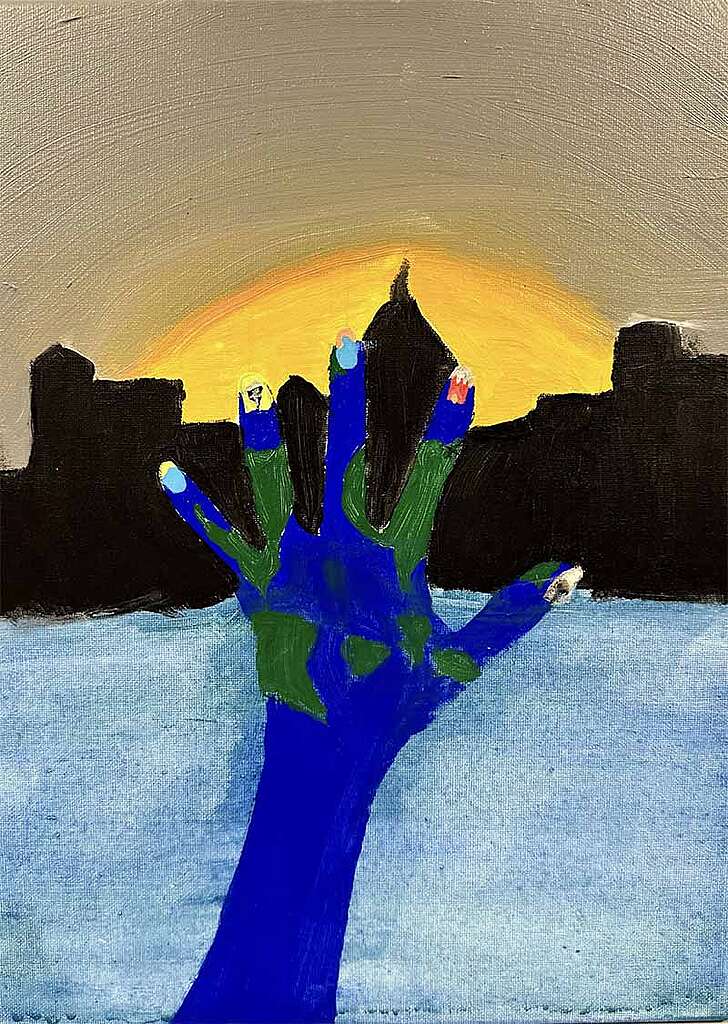
Our Touch
Jali and (Year 5 Student)
Do we choose rising oceans or rising actions?
‘Our Touch’ was created by two students at the Living School in Year 5 and Year 8. With the challenges of climate change becoming more apparent and the number of climate refugees increasing, this artwork advocates for Sustainable Development Goal 13, Climate Action. This artwork highlights the effects of rising sea levels caused by pollution, halving pollution is a vital step towards minimising climate change impacts.
The most visible meaning in this artwork is to raise awareness around rising sea levels. However, the underlying goal is to show people that one person can make big differences, especially in a time of crisis. The artists hope that ‘Our Touch’ brings the viewers emotions of empowerment through the uniqueness of art.
Elements of art are regularly used in this artwork. The vivid colour of the nail art draws attention to the disaster depicted. The dark sharp lines of the skyline give perspective and contrast against the vibrant but fading sun.
Promoting the message of halving pollution to reduce global warming and rising sea levels, this artwork is a form of art-ivism. With the hand decorated as the earth, the artwork hopes to show that climate change doesn’t just hurt one person, it hurts the whole world, and inspires everyone to take action.
In all, ‘Our Touch’, provides a visual call to action and empowerment. As the world continues on this negative downward spiral, we must come together to create an impact.
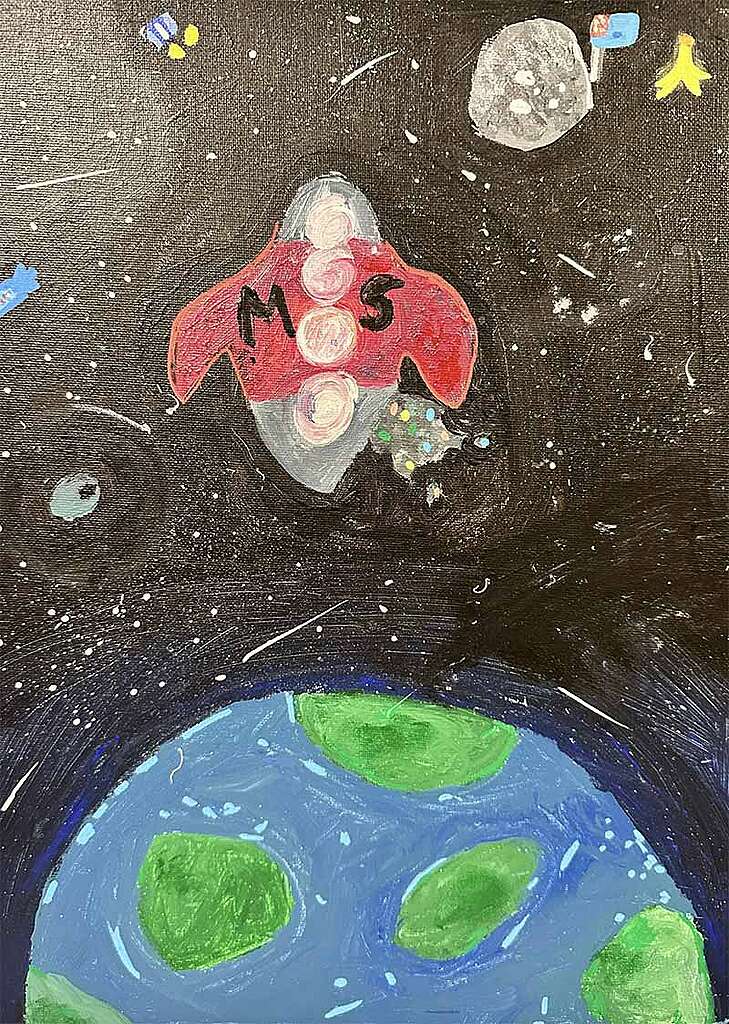
Earth Away
(Year 5 Student) and Sage
This artwork, ‘Earth Away’, was created by two students at Living School in Year 5 and Year 8. They address Sustainable Development Goal 13 which focuses on Climate Action. The artist chose to advocate for halving pollution which is a crucial step towards sustainability and a healthy environment.
The artwork, ‘Earth Away’, aims to promote awareness around climate action. Art has the unique ability to evoke emotions and inspire other artists. Through the use of various elements of art, blending lines, colour and texture, we promote the message of climate action. We tried to use the same colours as how they look in real life. We feel passionate about the future of our earth.
Overall, this artwork serves as a visual call to action, urging individuals to make conscious choices that will eventually help the earth if we all start now. We want to have a positive impact on our future.
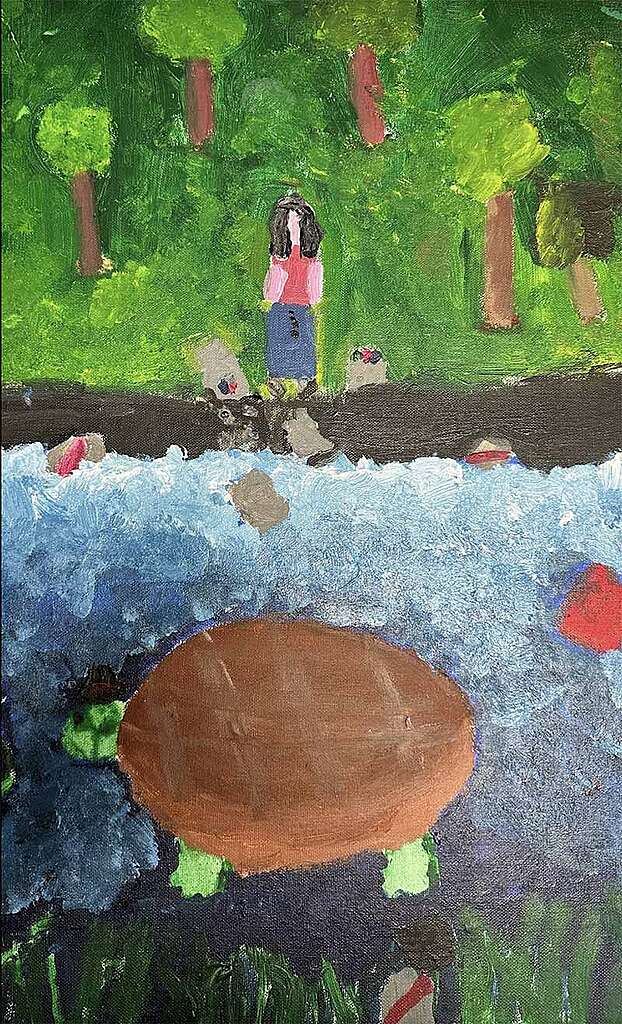
Not a Perfect World
Rose, Lui, Vaan, Scarlet, Banksia
This artwork, ‘Not a Perfect World’, was created by five students at Living School in Year 5, Year 6 and Year 7. The artwork addresses Sustainable Development Goal 14, which focuses on Life Below Water. The artists chose to advocate for halving pollution, which is a crucial step towards the earth.
This artwork underscores the critical role of art raising awareness about climate change. Art has a unique ability to evoke emotions and make viewers feel passion about the painting. Through the use of various elements of art, blending the paint together and adding texture to our painting.
By promoting the message of the knowledge that there is too much pollution in the water and turtles are dying. Overall, this artwork serves as a visual call to action, uring individuals to make conscious choices that will help the environment to build a sustainable life.
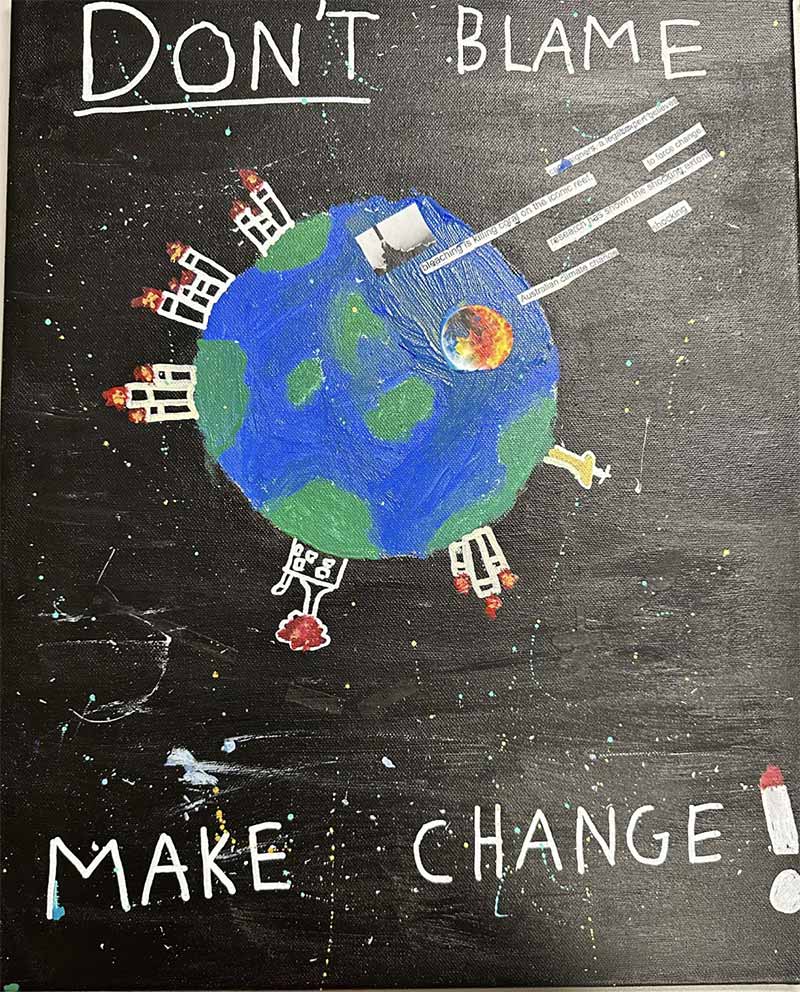
Don’t Blame, Make Change
Archie and Max
The artwork, ‘Don’t Blame, Make Change’, was created by two students at Living School in Year 6. The artwork addresses Sustainable Development Goal 13, which focuses on Climate Action. The artists chose to advocate for halving pollution and waste which is a crucial step towards a healthy and sustainable ecosystems here on earth.
This artwork aims to provide awareness around critical concepts surrounding climate change and the health of our environment. Evoking emotion can be a difficult take to achieve but art can empower emotions.
Through the use of various elements of art, such as line, colour, shape and collage, we promoted the message of climate action and to stop pollution which will lead to a healthy and sustainable earth.
Overall, this artwork serves as a visual call to action, urging individuals to make conscious choices that will save the world.
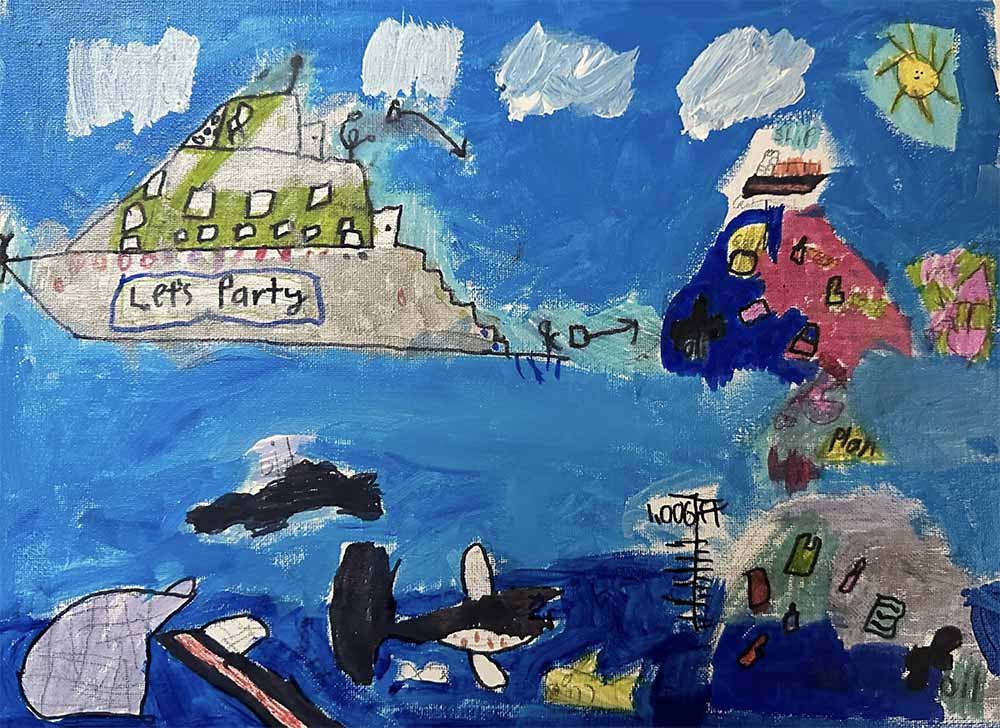
Stop Being A Tosser
Linny
I created ‘Stop Being A Tosser’ with my own hand power alone. The artwork addresses SDG 6 which focuses on Clean Water and SDG 14, Life Below Water.
I chose water as my Halve It focus because I love the ocean and fishing. We will destroy the environment if we do not care for our oceans.
I have used colour to show depth and to draw attention to the issue of water pollution.
I aim to inspire viewers to save the waterways and stop being a tosser.
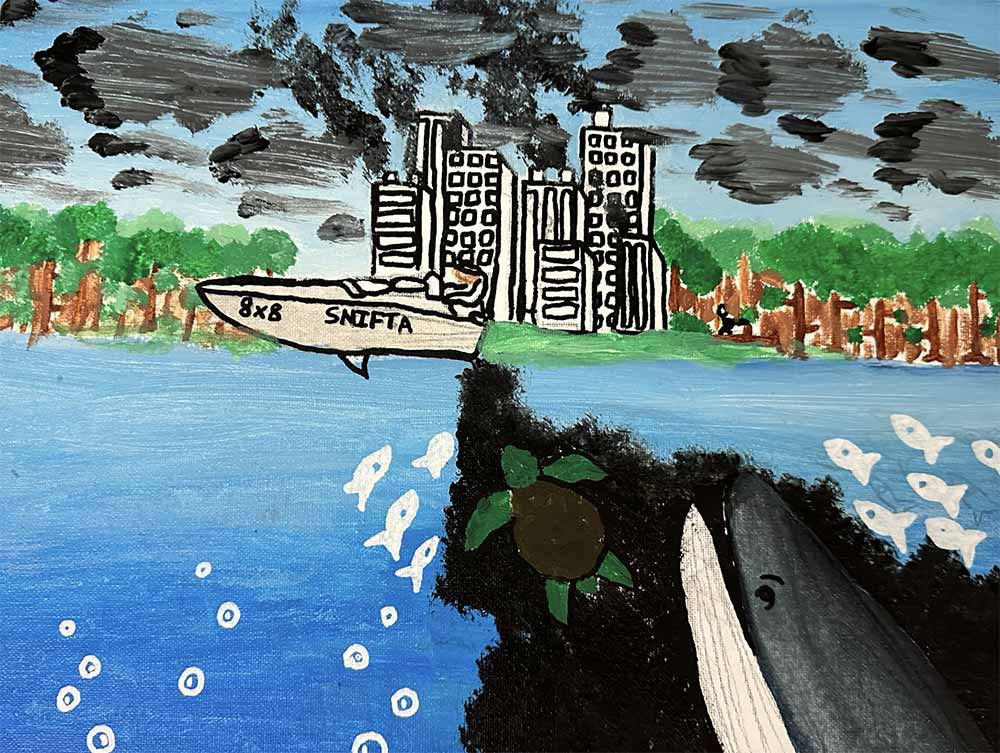
Wasted
Floyd and Sally
This artwork, ‘Wasted’, was created by Floyd and Sally, Year 7 and Year 8 students from Living School. We chose the SDGs 11, 13, 14 and 15 – Sustainable Cities and Communities, Climate Action, Life Below Water and Life on land. We chose to focus on pollution and environment in regards to Halve It.
We tried to evoke emotion through overwhelming the viewer with as many climate problems as we could.
Our clouds, oil and leaves are full of texture and the strong lines of the boat and buildings were designed to stand out.
Our aim was to inspire viewers to start being aware of themselves and to stop polluting and destroying the planet.
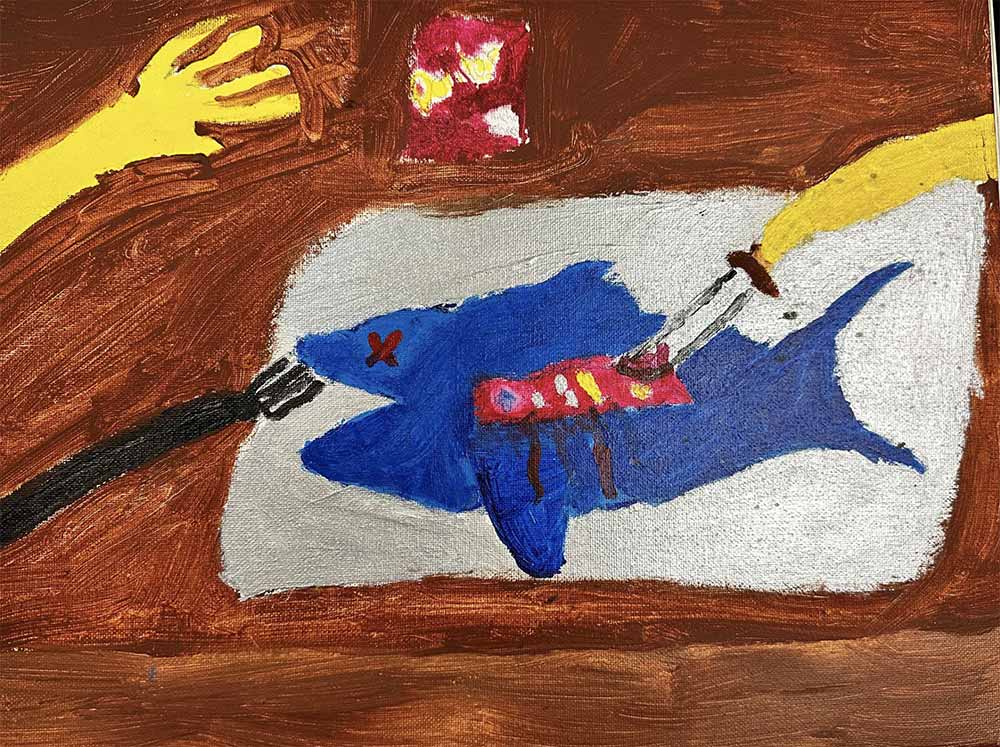
Fish Plastic Cycle
Toto and Theo
This artwork, ‘Fish Plastic Cycle’, was created by Theo and Toto, two smart Year 5 students from Living School.
The artwork focuses on SDG 13 and 14, which are Climate Action and Life Below Water. The Halve It focus is pollution and water.
We painted the cycle of throwing plastic in the water, the fish eat it, then we eat the fish.
We used elements of art to make the viewers feel emotions. We used bright colours for the plastic so it stands out. We also used big, simple shapes to create attention.
Through our artwork, we hope to inspire people to buy reusable products and not throw rubbish in the ocean.
Overall, this artwork aims to bring awareness to plastic pollution and how our actions always impact us.
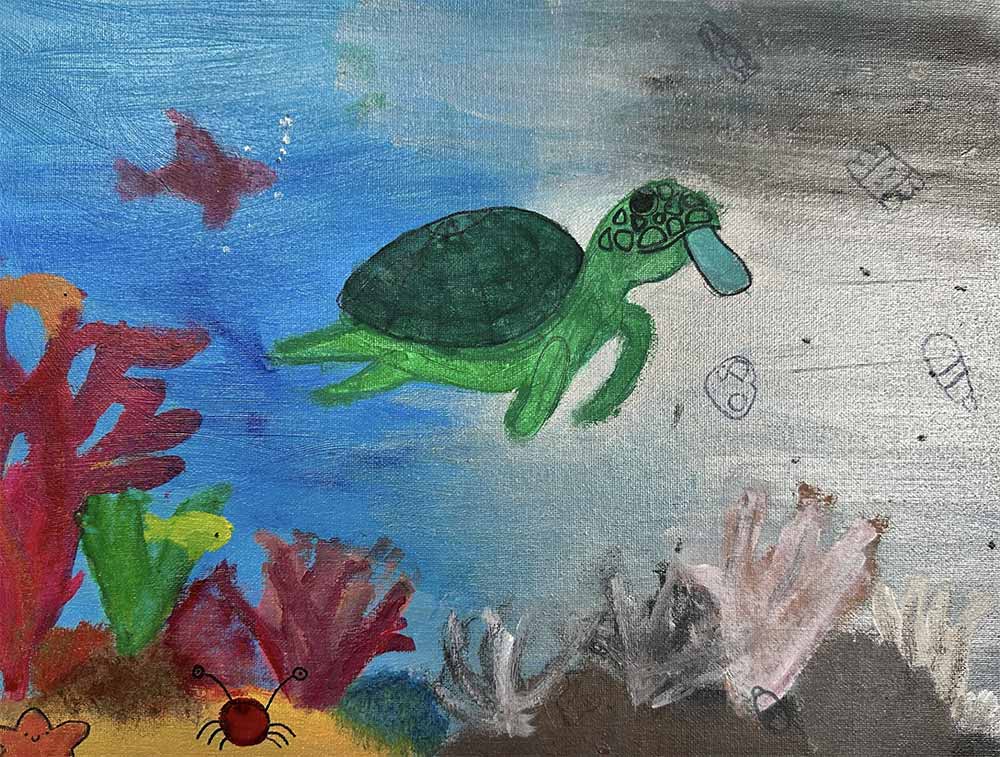
More Rubbish, Less Life
Alexa and Kotomi
This artwork, ‘More Rubbish, Less Life’, was created by Alexa and Kotomi, two Year 5 students from Living School. The work addresses SDG 14 – Life Below Water and we chose to focus on Halve It – Environment.
We chose to paint a turtle half happy, half sad and what the ocean could be and what it is now.
We used colour, shade and hue to show the bright side and the dark side of this story.
Through our artwork, we hope viewers will know what the world could be if we actually tried.
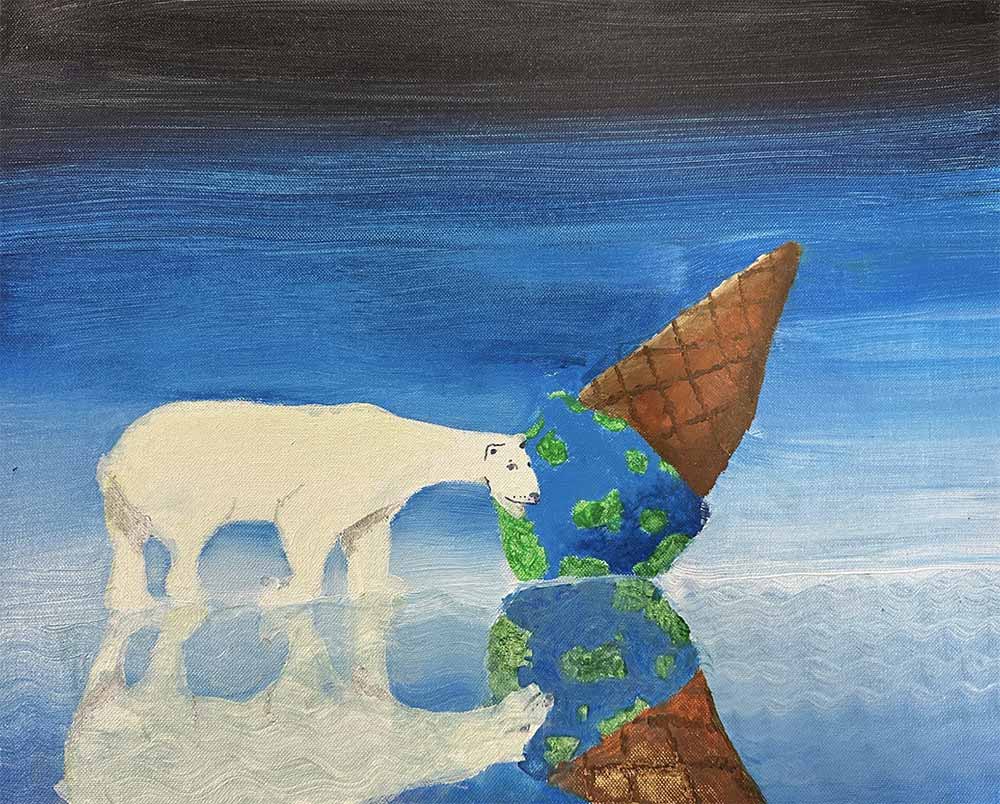
I Scream, You Scream, We All Scream For Action!
Minnie and (Year 6 Student)
This artwork was created by Minnie and (Year 6 Student), a Year 8 and Year 6 students. We chose two Sustainable Development Goals, 13 – Climate Action and 4 – Quality Education. 13 was chosen to represent the melting ice caps killing polar bears. This is why we added the melting ice-cream, making a reflection for the earth and polar bear. 4 was chosen because it is crucial to teach everyone, especially our future generations, what is really happening to the world so that we can SCREAM for action. For Halve It, we chose environment because of our heating planet and melting ice cape.
The elements of art that we used were texture for the polar bear’s fur and rippling water. Colour to show shade and hues. All of this makes you stop and stare, inspiring the viewers to try and do something. Overall, this artwork aims to make you feel wonder and urgency to do something about our melting planet.
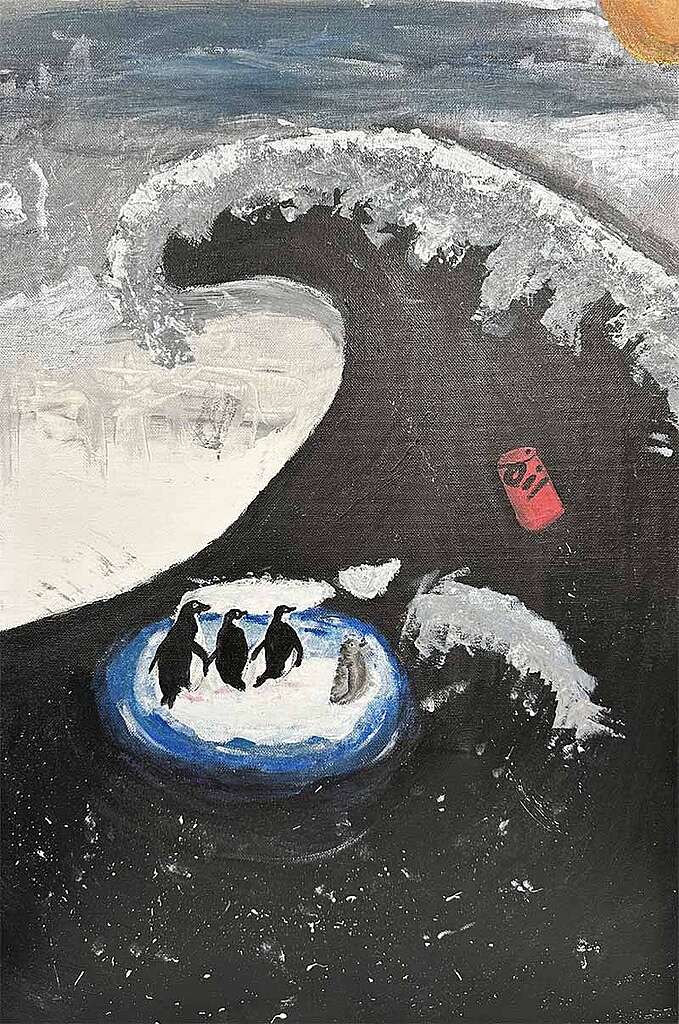
The Last Penguins
Loretta, (Year 8 Student) and Indi
The people involved in this creation are, Loretta, Lorien and Indi. We are addressing SDG 14, Life Below Water in this painting. Our Halve It focus is a cross between pollution and environment.
We have tried to evoke emotions in this painting by showing that the ocean is getting filled with things like oil spills, which in turn, is killing the penguins and sea life.
In the sky and the top of the wave, we have used texture, tone and colour to blend it and make it seem more real. We used very well defined shapes for penguins.
We aim to inspire viewers to donate to foundations like Sea Shepherd and Greenpeace and also to reflect on their own impact on the ocean ecosystem, which they don’t usually see in everyday life.
All in all, we aim to raise awareness of the oceans fate with this painting.
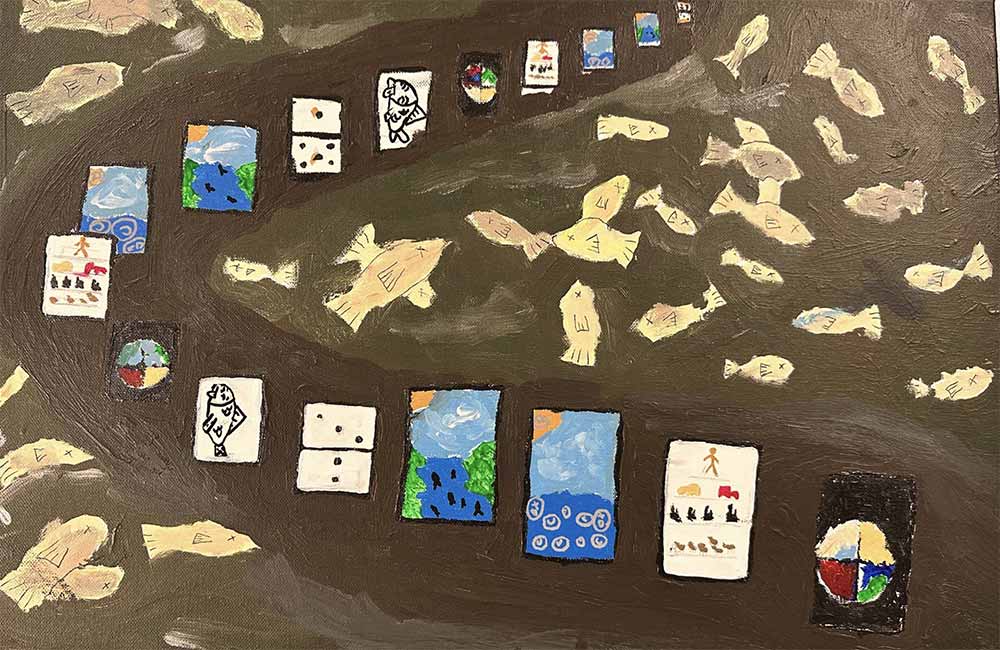
Deadfish Dominoes
Piper, Miles, Kasper, Wolfie
This piece of art titled, ‘Deadfish Dominoes’, was created by four Year 7 students, Piper, Miles, Kasper and Wolfie. This artwork was created to highlight the importance of SDGs 6 and 14. These foals focus on the health of water. 6 being Clean Water and Sanitation and 14 being Life Below Water.
This artwork showcases the disaster that took place in the Murray-Darling river, where thousands of Murray Cod floated up to the surface, dead due to the lack of oxygen. This piece also shows the steps that have been taken to get to this point. And the steps that may well be taken if we don’t change our course. Black water events, such as these, cause detrimental effects to the river, causing many plant and animal life populations to rapidly deplete, causing negative effects to the environment and sanitation of the water system.
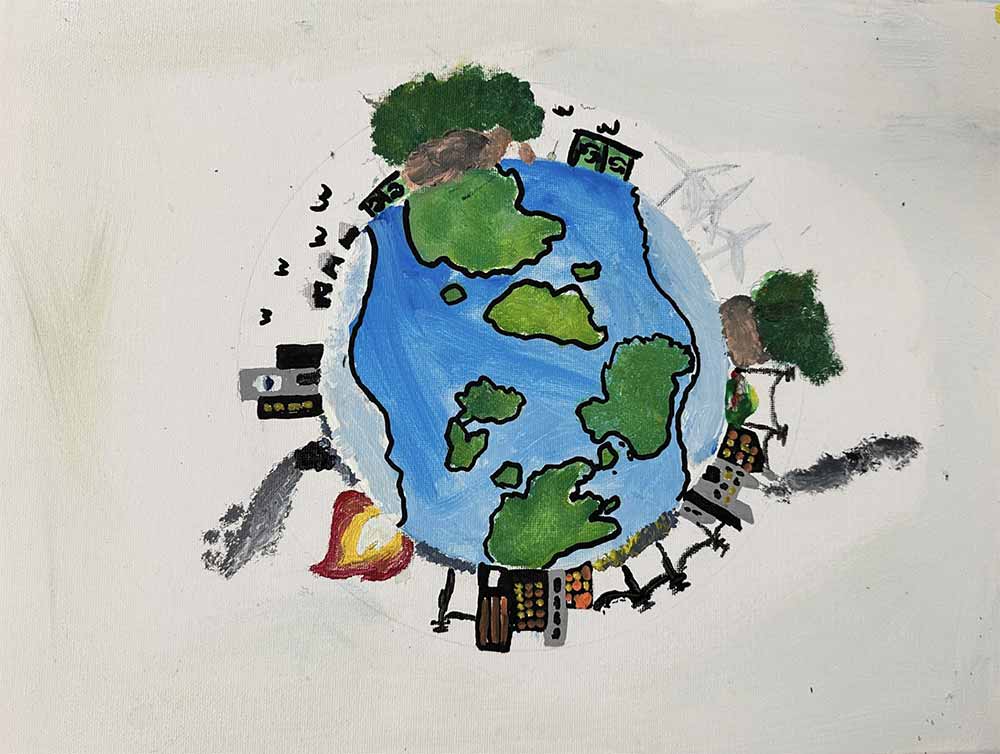
Unstable Reality
(Year 8 Student)
This piece, ‘Unstable Reality’, was designed by a Year 8 students of Gudji. It is focused on SDG 13 Climate Action.
It shows how the world is majority industries and factories, even though we are working towards sustainability and renewables, it shows how the industry need to set fire to fossil fuels and eliminate greenhouse gasses for a greener, better world.
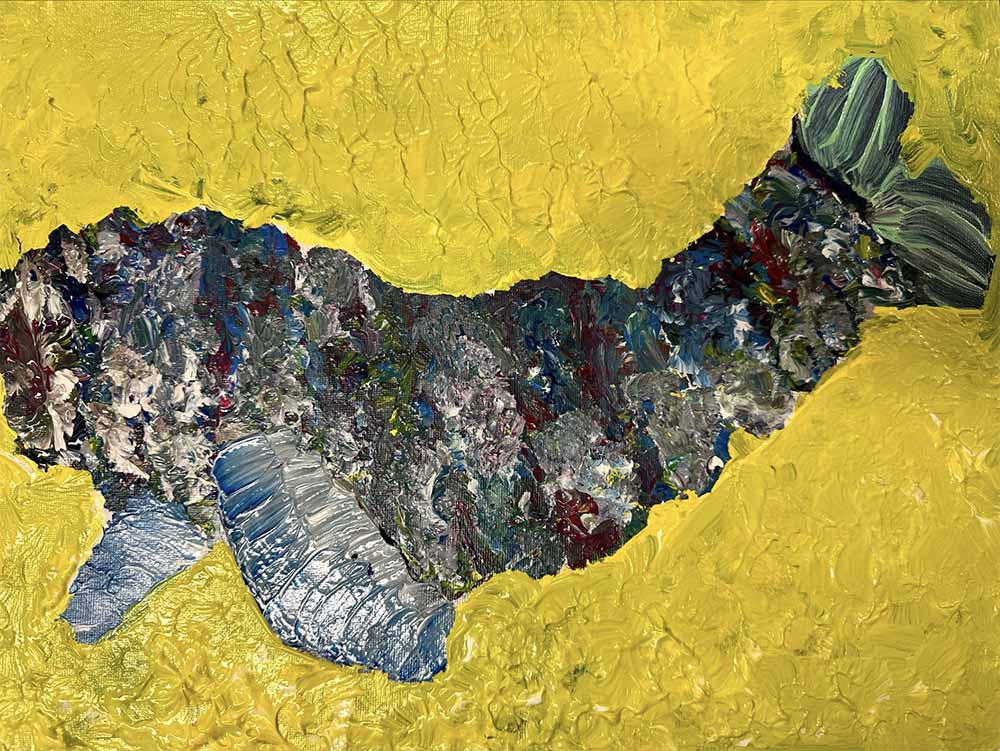
The Plale
(Year 8 Student)
This wonder of art was designed by a Year 8 students of Gudji at Living School. This follows a work of art-ivism of Sustainable Development Goal 14. Goal 14 is a goal dedicated to protecting and conserving our wildlife in the ocean. Many companies dedicated to work and volunteer to help them.
This texture of this artwork features a bumpy, raised body, showing that the body of the whale is made out of plastic. The background shows the polluted water because of our litter and machines. Leaving rubbish on our floor drains into our oceans and hurts our wildlife underwater.
This artwork has been through decent layers to create a shaping effect of the crumbling plastics qualities.
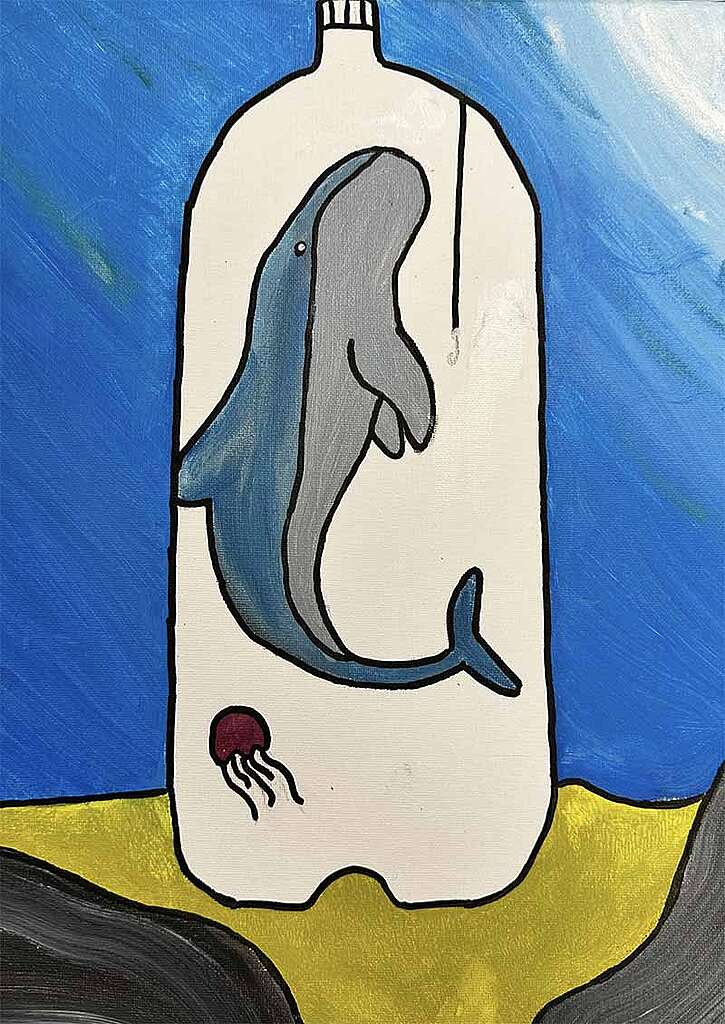
Ocean In A Bottle
(Year 8 Student)
This design was created by a Year 8 member of Gidji from Living School. This work of art is a work of art-ivism of SDG 14. Sustainable Development Goal 14 focuses on Life Below Water. Helping save animals and protect them from rubbish and our pollution.
This design shows our animals being trapped within our bad creations and fast fashion. Plastics like the plastic bottle the whale and jellyfish are stuck in is rubbish that has blown into our drains and washed into our oceans.
This shows materials from on land and the sea. To design this masterpiece, there were uses of paint brush strokes intricately placed to change the colours and placement of shape.
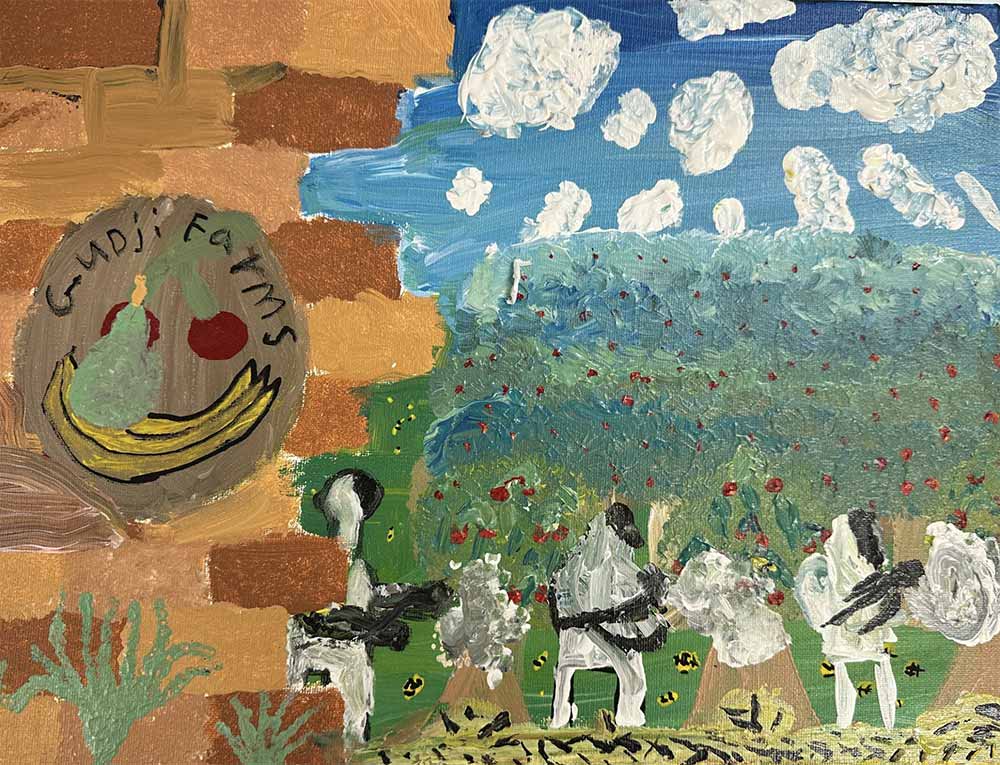
Gudji Fruit Farms
Flo
This artworks focuses on bees being killed by pesticides which is a huge problem. Bees are a huge part of life. They pollinate flowers which can bloom into fruit and vegetables. 1 in every 3 bites we get from bees. When people use pesticides and a bee lands on the flower, the pesticide infects the bee.
When the bee goes back to the hive, the entire hive can become infected, causing the bee keeper to burn the hive and all the bees inside to stop infection from spreading to other hives. Every bee who lands on a flower infected with pesticide is another life lost. You may think, so what if bees are dying? Well, as hive after hive dies, we, along with bees, creep closer to extinction.
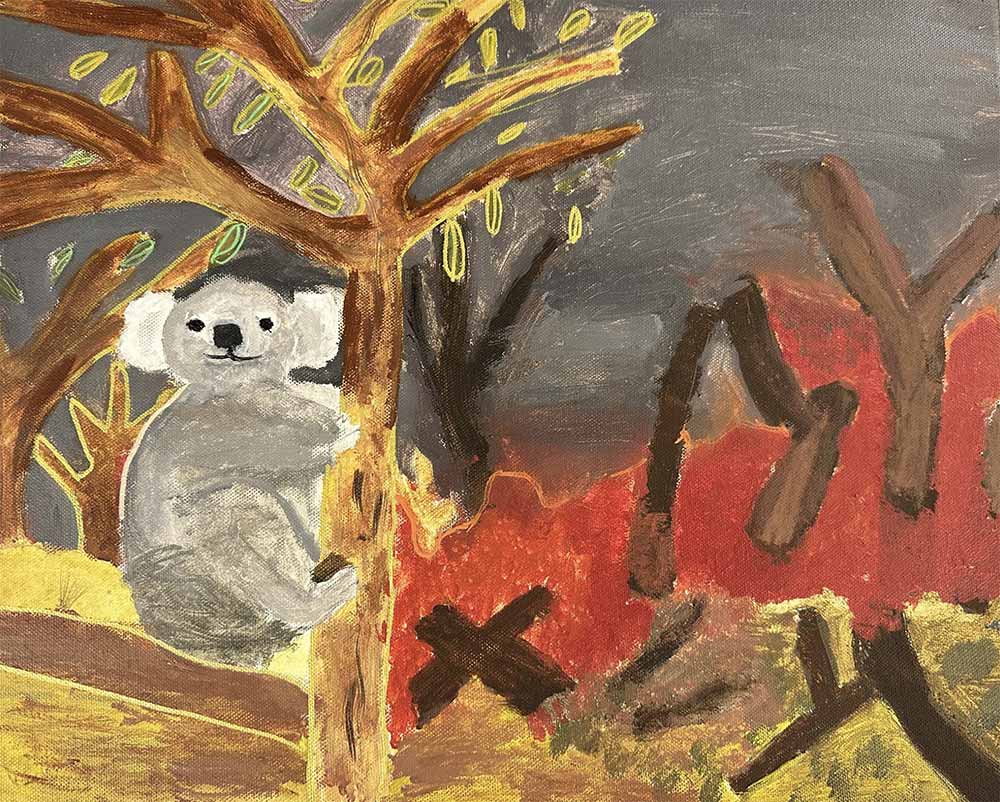
Koala
Willow, Marley, Ryder, Banjo
We have made this artwork to show the impacts of climate change on species like koalas, mainly in southern and eastern Australia. Global warming can make bushfires that burn down koala habitats and more.
We are chopping too many trees.
Feral cats and dogs can kill native wildlife. There are unsustainable practices of forestry all around Australia.
If koala’s homes are burned or chopped down, it will force it to move to another home but what if there isn’t another home to go to and trying to get to another home means crossing roads so it could get run over?
Forestry corp has a history of doing some illegal forestry. They used to cut down habitats and trees! Why do these companies do this? We can have a house but by giving us a house you give native animals from Australia no house.
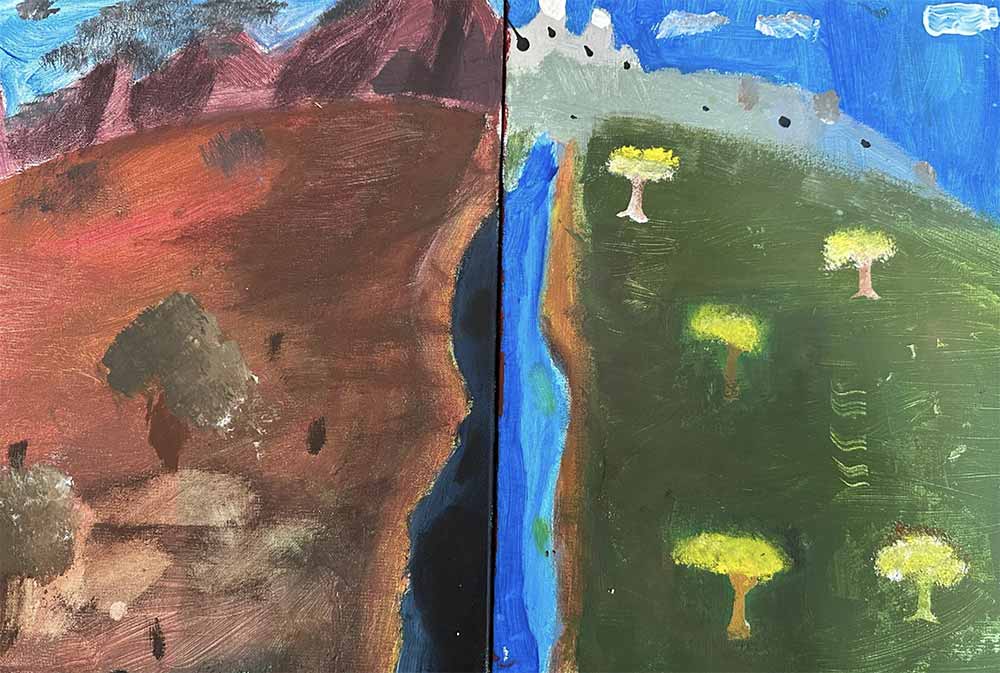
Split Rivers
Javier, Araluen, (Year 6 Student), (Year 5 Student)
This diptych artwork was made by four students from Living School in Years 5 and 6. We had two students working on each painting. We decided to split the image across two canvases to show the polarity between how the earth could be, and the way we are currently going.
Our art addresses both sustainable development goal 14 and 15, Life Below Water and Life on Land. They are linked because the health of the land impacts the water and the health of the water impacts the land. We wanted our audience to realise that our beautiful country can become a wasteland if we don’t take charge.
Overproduction of oil, chemical and rubbish pollution, land clearing and other unsustainable practices are destroying the health of our rivers. We want our artwork to inspire people to consider the effect of their choices on the land. If we don’t, we will all face the consequences.
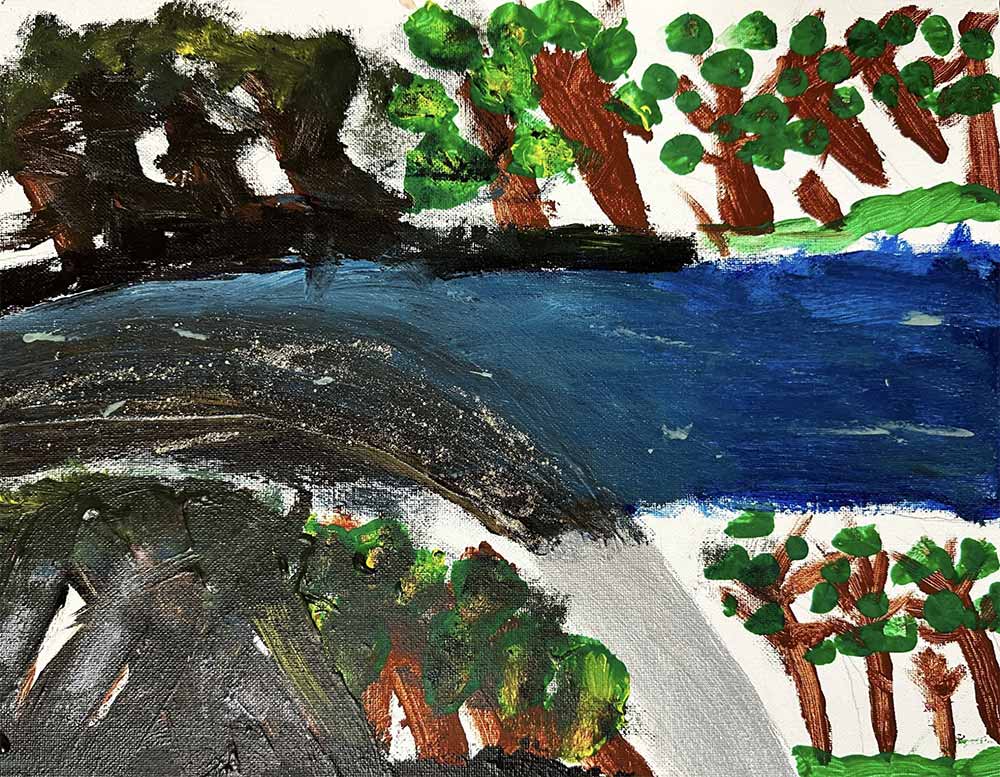
The Silver River
Cooper
‘The Silver River’, by Year 5 student Cooper, addresses issues around waterway protection.
This artwork highlights the importance of SDG 14, Life Below Water because there is pollution and goodness.
This artwork uses glitter to add texture but also represents the glittery nail polish that impacts our waterways. It shows the oil pollution that coats animals in toxic oil forever. It also bleaches things and kills trees.
It also places importance on the Halve It goal of water, which we need to protect.
The use of lines show the flow of water.
We MUST stop the use of oil and production of cars, unless they are hybrid.
STOP WATER POLLUTION NOW!!
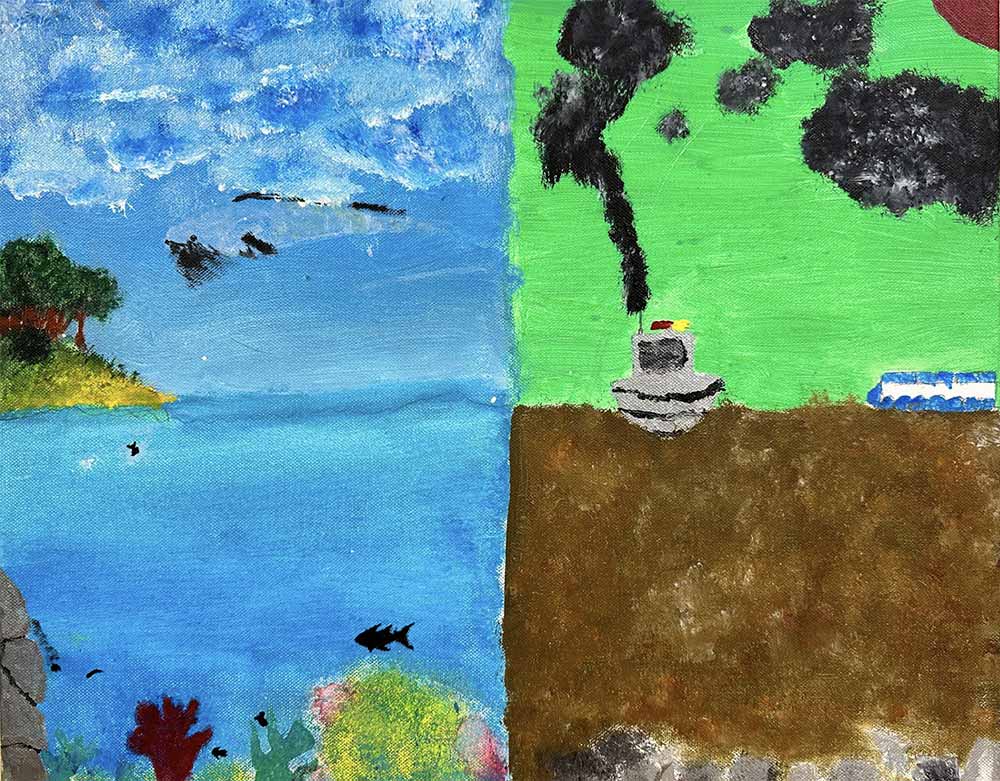
Fish-dom
(Year 8 Student) and Zai
This artwork was illustrated by to young 13 and 12 year old boys at Living School. The painting named ‘Fish-dom’ outlines the tench Sustainable Development Goal which focuses on Life Below Water, as in fish, crustaceans and other species of water animals and plants.
(Year 8 Student) and Zai decided to end up on Life Below Water because of the overfishing problems in Australian rivers and oceans.
Through the various elements of art and details of the painting, the illustrators centered the focus on the differences of sides, which is sustainable and unsustainable.
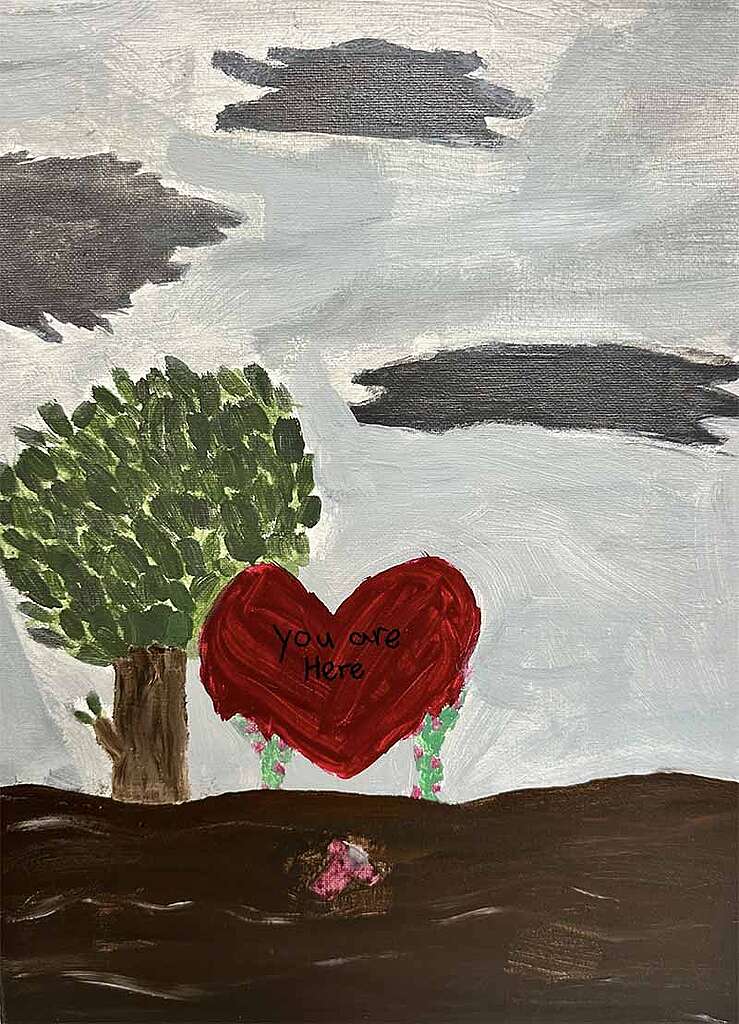
You Are Here
Molly and Indie
This artwork was created by Molly M in Year 5 and Indie H in Year 6. We created this artwork of a statue in Lismore in the floods. We chose it because we are sick of our community going through the same terror every year and seeing people lose so much while the government does so little. The floods of 2022 left hundreds of people homeless and some people lost family members and pets.
We want our community to understand how much rubbish we are dumping in our river and how climate change will make natural disasters words. We are commenting on SDG 13, Climate Action. We want to Singapore our leaders to realise how important it is to make change and make sure we don’t leave anyone behind.
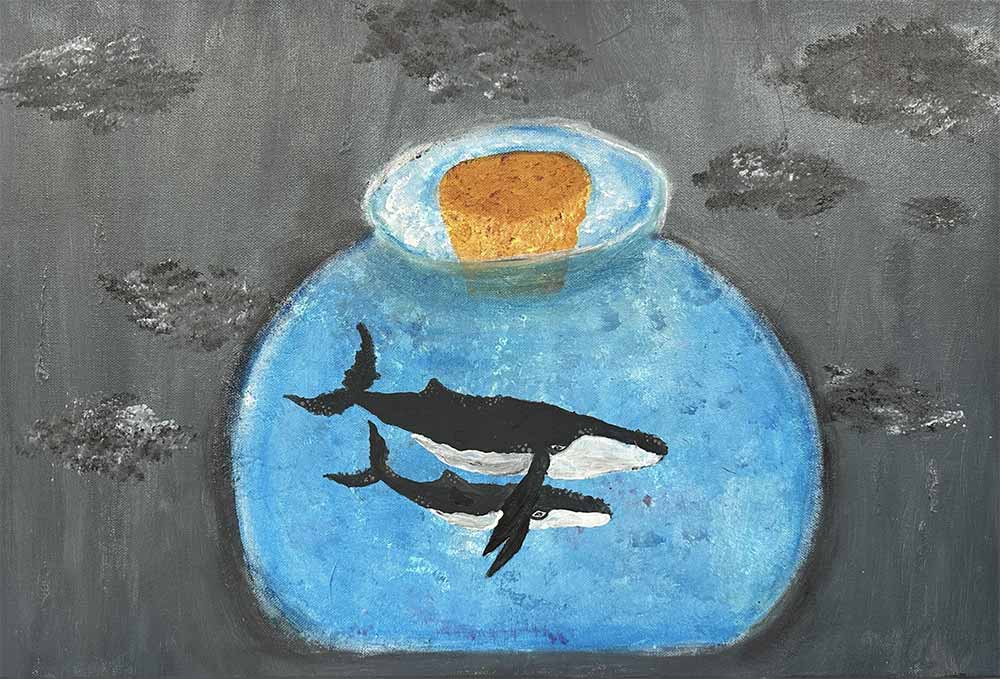
Enclosed
Mia, (Year 7 Student) and Eavie
This artwork was created by Mia in year 7, (Year 7 Student) and Eavie in Year 8 from Living School. We are addressing waterways health and Sustainable Development Goal 14: Life Below Water. We created this artwork to show that keeping animals captive is not ok.
Removing them from ecosystems has a real negative impact on the planet, The real question is, why DO we keep animals captive? The answer is simple, for our own entertainment and greed. How would you feel is someone took you from your home where you were free to roam and put you in a tiny little box?
You aren’t just stripping the animals of a good life, you are disrupting the environment they were in. This artwork was designed to spread awareness about how the animals must feel, and make a statement about the impact of humanity’s greed.


